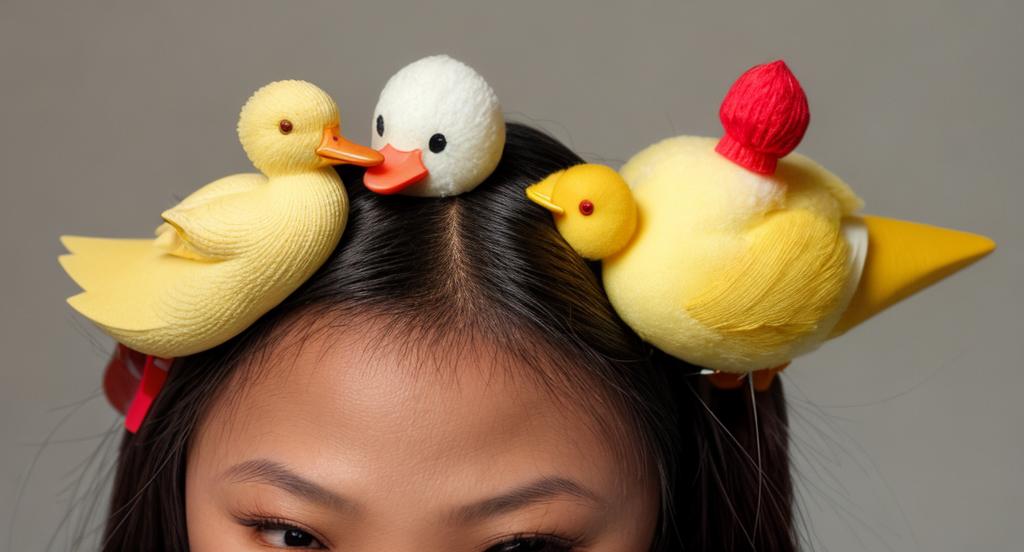In recent months, a peculiar trend has taken the Philippines by storm, uniting fashion enthusiasts and the general populace in a shared fascination for a whimsical accessory: the duck hair clip. From the bustling streets of Manila to the serene landscapes of Baguio, these adorable clips have not only become a fashion statement but a cultural phenomenon. This article delves into the origins, widespread appeal, and the unexpected benefits of this quirky trend that has everyone asking, “May bibe na ba lahat?”

Get your own bibe hair clip here!
The Humble Beginnings
The duck hair clip craze traces its roots back to China in 2015, initially featuring bean sprouts and other plant-themed accessories before evolving into the duck-themed clips we see today. However, it was in Baguio City, during an anime cosplay convention in either August or October 2023, that the trend truly took flight in the Philippines. The city, known for its creative spirit and vibrant youth culture, became the perfect breeding ground for this unique fashion statement to spread.
- The trend’s origins in China and its evolution
- Baguio City as the Philippine trendsetter
- The role of youth and creativity in its popularity
A Nationwide Sensation
What started as a niche accessory at a local event quickly spread across the country, capturing the hearts of Filipinos of all ages. The clips have been spotted in various locales, from Laguna to La Union and even in the bustling Chinatown during the Chinese New Year celebrations. The appeal of the duck hair clips lies in their ability to add a touch of whimsy and nostalgia, making them a hit not just among the youth but also among the young at heart.
- Spread of the trend across the Philippines
- The diverse appeal of duck hair clips
- The role of social media in amplifying the trend
Beyond Fashion: Economic and Cultural Impact
The popularity of duck hair clips has had a tangible impact on local economies, particularly for vendors in markets like Divisoria and Binondo, where the clips are sold for as little as P35 each. The trend has provided a much-needed boost to these vendors, highlighting the potential of viral trends to support local businesses. Furthermore, the clips have become a symbol of Filipino ingenuity and the ability to embrace and adapt global trends to local contexts.
- Economic benefits for local vendors
- The duck clip as a symbol of Filipino creativity
- The trend’s reflection of the Philippines’ vibrant culture
The Psychology Behind the Quack
Experts, including a pop culture and literature professor from the University of the Philippines-Diliman, have weighed in on the phenomenon, attributing its popularity to the “bandwagon syndrome.” This desire to be part of a trend is not unique to the Philippines but is a global phenomenon. However, the duck hair clip trend also taps into a deeper longing for connection and joy, offering a simple yet effective way for Filipinos to express themselves and share in a collective experience.
- The “bandwagon syndrome” explanation
- The deeper meanings behind the trend
- The role of trends in fostering community
Educational Institutions’ Stance
The Department of Education (DepEd) in the Philippines has recognized the trend’s benign nature, allowing students and teachers to wear the clips in schools. This acceptance underscores the trend’s widespread appeal and its perception as a harmless, fun accessory rather than a distraction. It also reflects a broader understanding of the importance of self-expression and belonging among the youth.
- DepEd’s stance on duck hair clips in schools
- The importance of self-expression in educational settings
- The trend’s impact on youth culture
Looking Ahead: The Future of the Trend
While trends are inherently fleeting, the duck hair clip phenomenon shows no signs of waning anytime soon. Its ability to evolve, from simple yellow ducklings to designs featuring umbrellas, hearts, and even sunglasses, suggests that the trend may continue to captivate the imagination of Filipinos. As the trend progresses, it will be interesting to observe how it adapts and what new forms it may take.
- The evolving nature of the trend
- Predictions for the future of duck hair clips
- The potential for new trends to emerge from the duck clip craze
The duck hair clip trend in the Philippines is more than just a fashion statement; it’s a testament to the power of whimsy and nostalgia in bringing people together. From its origins in China to its blossoming in Baguio City and beyond, the trend has captured the hearts of Filipinos nationwide, offering a slice of joy and a boost to local economies. As we look to the future, the enduring appeal of these charming accessories serves as a reminder of the enduring human desire for connection and expression.
- Where did the duck hair clip trend originate?
- The trend originated in China in 2015 with plant-themed accessories and evolved into duck-themed clips.
- How much do duck hair clips cost in the Philippines?
- Prices vary, but in markets like Divisoria, clips can be sold for as low as P35 each.
- Why have duck hair clips become so popular in the Philippines?
- Their whimsical design, nostalgic appeal, and the joy they bring have contributed to their popularity.
- Can students wear duck hair clips to school?
- Yes, the Department of Education has stated that these clips are considered harmless and can be worn in schools.
- Will the duck hair clip trend last?
- While trends are unpredictable, the evolving designs and continued popularity suggest it may last for some time.
